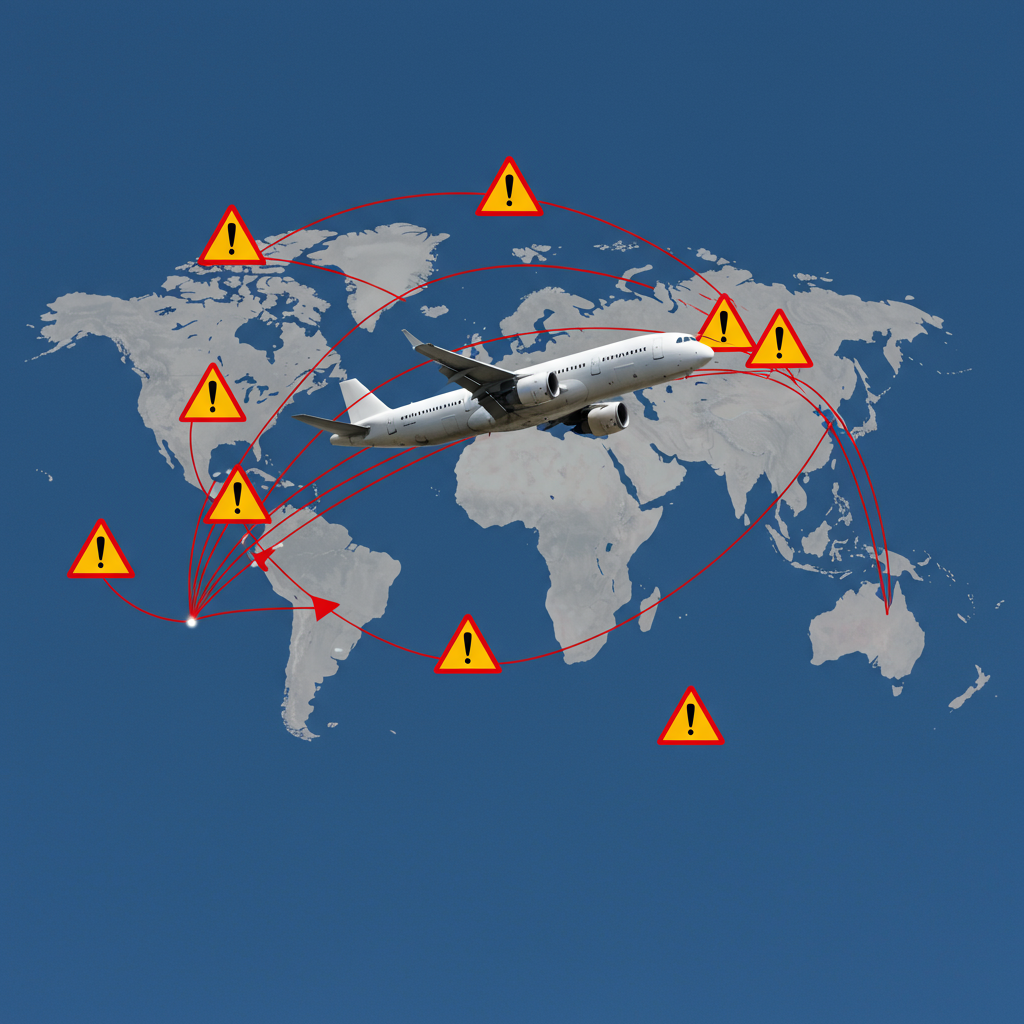Global conflicts are increasingly constricting the world’s skies, forcing airlines to navigate treacherous or off-limits regions. This shrinking safe airspace is directly impacting the aviation industry, leading to longer flight paths, ballooning operational costs, increased delays, and ultimately, higher fares for travelers.
As of June 2025, renewed tensions, particularly in the Middle East, are adding significant pressure on global carriers already grappling with previously closed corridors.
Middle East Tensions Ignite Fresh Disruption
The recent escalation in the Middle East, including targeted military actions and retaliatory strikes, has rapidly transformed vital air routes into high-risk zones. Key global aviation hubs in the Gulf are feeling the immediate impact.
Over a recent weekend, major carriers like British Airways, Singapore Airlines, and Air France-KLM cancelled flights to critical cities such as Dubai, Doha, and Bahrain due to the rising tensions and evolving airspace restrictions. British Airways specifically reported instances like a flight diverting back to London after entering Saudi Arabian airspace. Following an Iranian missile attack, Qatar even temporarily closed its airspace, disrupting operations for its national carrier and others.
The instability has led to widespread suspensions and cancellations impacting routes to destinations including Tel Aviv, Beirut, Baghdad, Tehran, Amman, and Erbil, with some airlines suspending services for weeks or even months.
The Compounding Crisis: Beyond the Middle East
The challenges posed by Middle Eastern conflicts don’t exist in a vacuum. Airlines were already operating under significant constraints imposed by earlier geopolitical events. Passenger planes have been avoiding Ukrainian airspace since the 2022 invasion, and most Western airlines remain banned from Russian skies.
This long-standing closure of vast swathes of Eastern European and Central Asian airspace has already created bottlenecks and made routes connecting Europe and Asia considerably less efficient for Western carriers. For example, London-Japan flights often struggle to compete with Chinese airlines that can still utilize more direct paths over Russia. The closure of Ukrainian skies has also contributed to air traffic control congestion across Europe as airlines funnel into narrower corridors. The current situation in the Middle East threatens to replicate and worsen this congestion in another critical region.
Navigating the Dangerous Sky: The Cost of Rerouting
With traditional, efficient routes over conflict zones now off-limits, airlines are forced to undertake lengthy detours. Flight tracking data clearly shows carriers rerouting northwards over Central Asia (via Georgia and Afghanistan) or southwards over Saudi Arabia and the Arabian Sea before turning east.
These diversions come at a steep price. Aviation analyst John Strickland notes that the Gulf region is inherently busy, and any restriction makes operations significantly more challenging, regardless of an airline’s base. Longer flight times mean:
Increased Fuel Burn: Aircraft fly for longer durations, consuming considerably more fuel – a major operational cost.
Higher Crew Costs & Risk of Cancellations: Extended flight times push flight crews towards or beyond their legal duty limits, increasing labour costs and raising the risk of last-minute cancellations due to crew non-availability.
- ATC Delays: Funneling more flights into limited airspace increases congestion, potentially leading to air traffic control delays on the ground and in the air.
- www.theguardian.com
- uk.finance.yahoo.com
- www.travelandtourworld.com
- www.inkl.com
- uk.finance.yahoo.com
The disruption also has wider economic ripple effects, threatening crucial cargo operations and fuel supply chains that rely on Middle Eastern logistics networks.
Safety Remains Paramount
Amidst the geopolitical turmoil, airlines consistently stress that safety is their utmost priority. The industry is keenly aware of the uncertain threats posed by modern drones and missiles in conflict zones. Regulatory bodies, such as the European safety agency EASA, have issued advisories warning against flying over specific regions like Syria, Jordan, Lebanon, and parts of Egyptian airspace since early June.
While unrelated to conflict airspace closures, recent events like a major aircraft crash involving Air India earlier this month serve as a somber reminder of the inherent risks in aviation and place added pressure on airlines to ensure absolute safety in route planning.
The Financial Toll and Impact on Travelers
The escalating crisis is having a tangible impact on airline finances. Share prices for many major carriers have dipped since tensions flared. Airlines are also closely monitoring the rising price of oil, particularly the cost of jet fuel, which has increased even more sharply than crude oil in recent weeks.
While fuel hedging strategies might prevent the full impact from being immediately passed on to passengers this summer, the increased operational costs from longer flights, coupled with existing pressures, make higher fares almost inevitable. Ryanair had already signalled fare increases this year, and the current situation only adds to the upward pressure on ticket prices.
For passengers, this means facing longer journeys, frequent delays, missed connections, and the uncertainty of last-minute schedule changes. Airlines like Israeli carrier El Al faced immense pressure, even operating limited “rescue flights” amid mass disruption. Travelers are advised to check flight statuses frequently and consider flexible booking options.
A Fundamental Shift for Global Aviation
Industry analysts describe the current situation as a “fundamental shift” for Middle Eastern aviation and highlight the “interconnected vulnerability” of modern air travel networks. A distant military action can, in effect, create an “aviation’s worst nightmare,” shutting down busy air corridors overnight.
While global demand for travel remains high, particularly for summer holidays, travelers are booking in a climate of increased uncertainty and potentially higher costs. The path forward remains fluid, with airlines continuously evaluating when and how to resume normal operations in the affected regions, leaving the skies over the Middle East and beyond less predictable for the foreseeable future.




